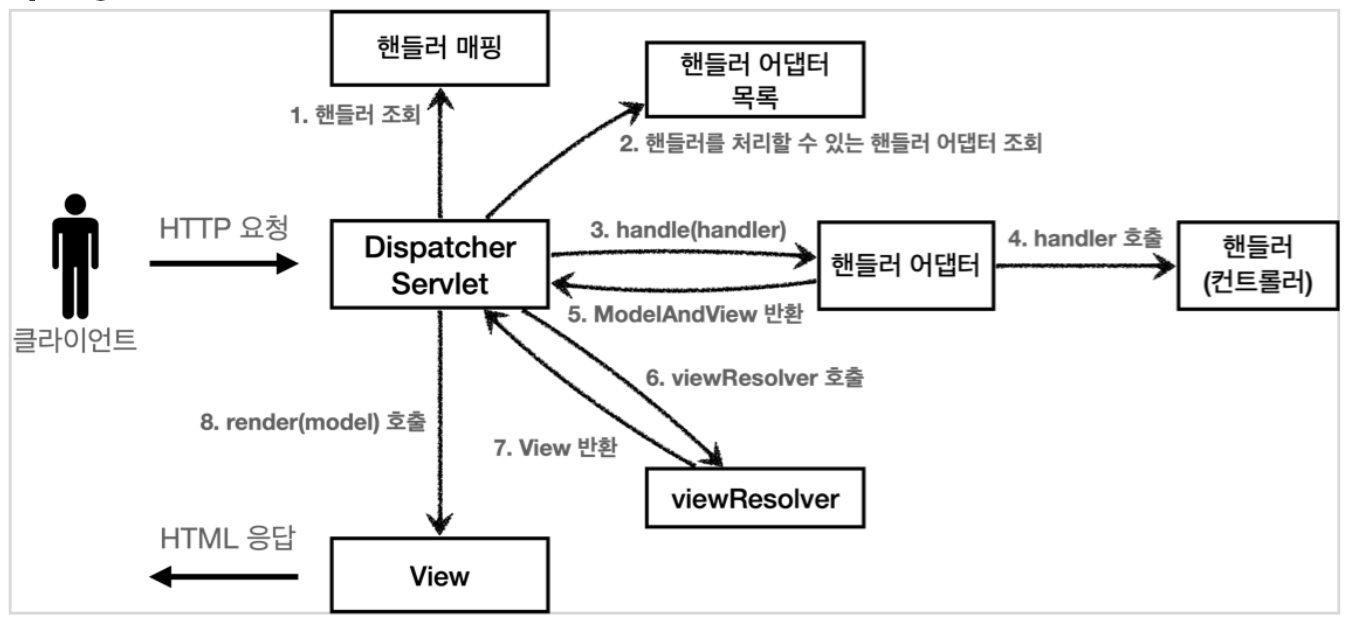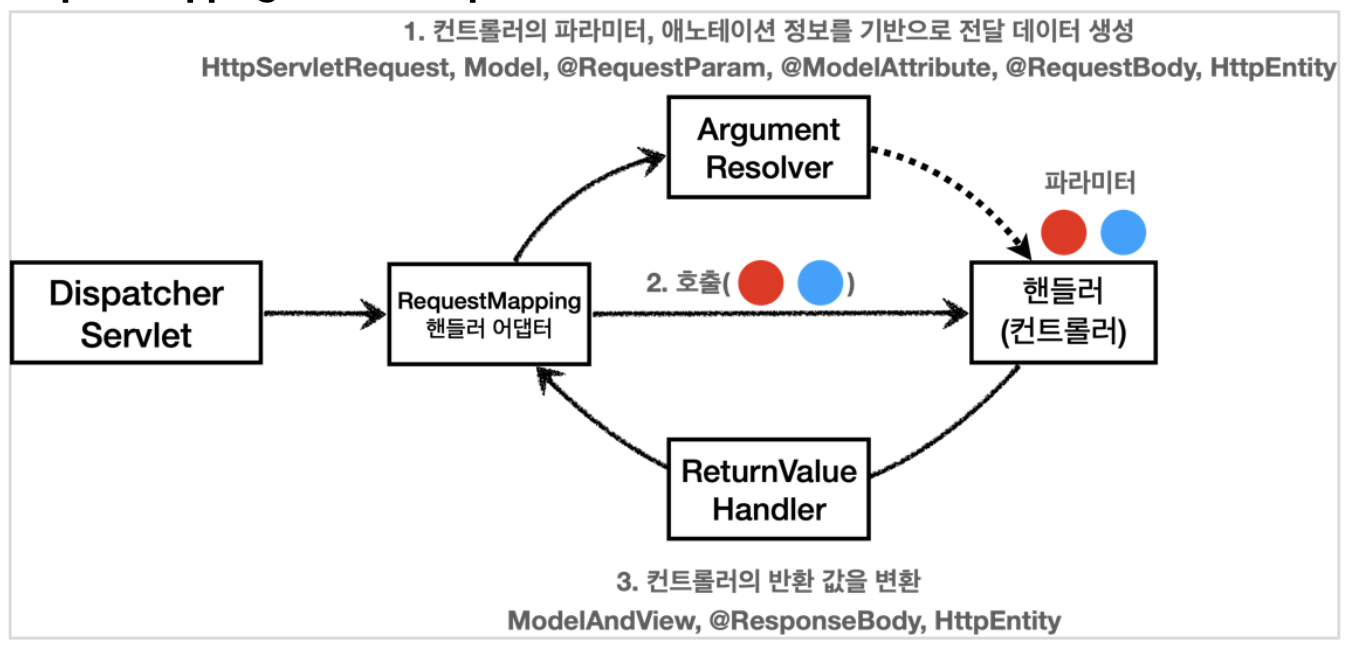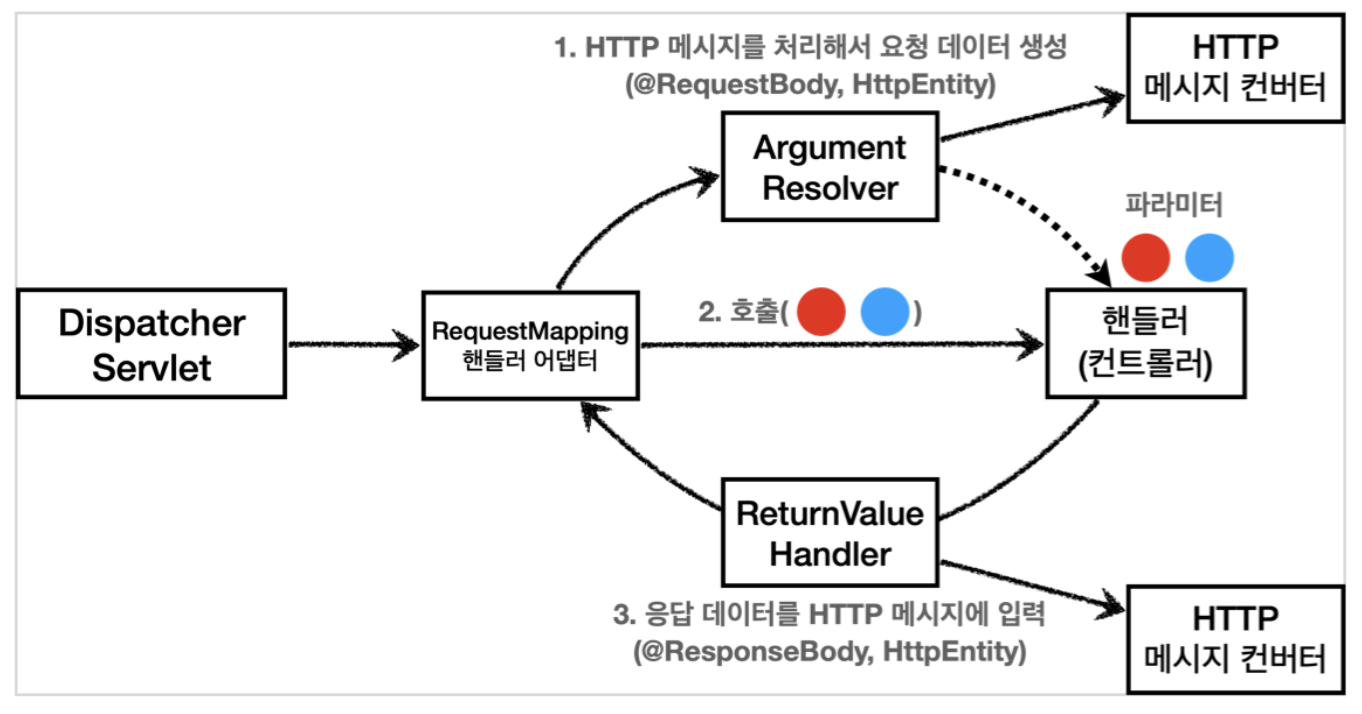[참고 강의] 김영한님의 스프링 MVC 1편 - 백엔드 웹 개발 핵심 기술
💡 스프링 MVC - 기본기능
✏️ 요청 매핑 핸들러 어뎁터 구조
그전 시간에 정리해본 HTTP 메시지 컨버터는 스프링 MVC 어디쯤에 사용되는 것일까?
Spring MVC 구조

@RequestMapping을 처리하는 핸들러 어댑터인 RequestMappingHandlerAdapter(요청 매핑 핸들러 어뎁터)에 있다.
RequestMappingHandlerAdapter 동작 방식

ArgumentResolver
애노테이션 기반의 컨트롤러는 매우 다양한 파라미터를 사용할 수 있다.
HttpServletRequest, Model과 @RequestParam, @ModelAttribute 같은 애노테이션 그리고 @RequestBody, HttpEntity 같은 HTTP메시지를 처리하는 부분까지 매우 큰 유연함을 보여주었다.
이렇게 파라미터를 유연하게 처리할 수 있는 이유가 ArgumentResolver 덕분이다.
애노테이션 기반 컨트롤러를 처리하는 RequestMappingHandlerAdaptor는 바로 이 ArgumentResolver를 호출해서 컨트롤러가 필요로 하는 다양한 파라미터의 값(객체)을 생성한다. 이렇게 파라미터의 값이 모두 준비되면 컨트롤러를 호출하면서 값을 넘겨준다.
ReturnValueHandler
ArgumentResolver 와 비슷한데, 이것은 응답 값을 변환하고 처리한다.
컨트롤러에서 String으로 뷰 이름을 반환해도, 동작하는 이유가 바로 ReturnValueHandler 덕분이다.
✏️ HTTP 메시지 컨버터
HTTP 메시지 컨버터 위치

요청의 경우
@RequestBody 를 처리하는 ArgumentResolver 가 있고, HttpEntity 를 처리하는 ArgumentResolver 가 있다. 이 ArgumentResolver 들이 HTTP 메시지 컨버터를 사용해서 필요한 객체를 생성하는 것이다.
응답의 경우
@ResponseBody 와 HttpEntity 를 처리하는 ReturnValueHandler 가 있다. 그리고 여기에서 HTTP 메시지 컨버터를 호출해서 응답 결과를 만든다.
💡 스프링 MVC - 웹 페이지 만들기
요구사항 분석
상품 도메인 모델
- 상품 ID
- 상품명
- 가격
- 수량
상품 관리 기능
- 상품 목록
- 상품 상세
- 상품 등록
- 상품 수정
✏️ 상품 도메인 개발
Item - 상품 객체
@Getter @Setter
public class Item {
private Long id;
private String itemName;
private Integer price;
private Integer quantity;
public Item() {
}
public Item(String itemName, Integer price, Integer quantity) {
this.itemName = itemName;
this.price = price;
this.quantity = quantity;
}
}ItemRepository - 상품 저장소
@Repository
public class ItemRepository {
private static final Map<Long, Item> store = new HashMap<>(); //static
private static long sequence = 0L; //static
public Item save(Item item) {
item.setId(++sequence);
store.put(item.getId(), item);
return item;
}
public Item findById(Long id) {
return store.get(id);
}
public List<Item> findAll() {
return new ArrayList<>(store.values());
}
public void update(Long itemId, Item updateParam) {
Item findItem = findById(itemId);
findItem.setItemName(updateParam.getItemName());
findItem.setPrice(updateParam.getPrice());
findItem.setQuantity(updateParam.getQuantity());
}
public void clearStore() {
store.clear();
}
}
✏️ 상품 목록 - 타임리프
BasicItemController
@Controller
@RequestMapping("/basic/items")
@RequiredArgsConstructor
public class BasicItemController {
private final ItemRepository itemRepository;
@GetMapping
public String items(Model model) {
List<Item> items = itemRepository.findAll();
model.addAttribute("items", items);
return "basic/items";
}
//테스용 데이터 추가
@PostConstruct
public void init() {
itemRepository.save(new Item("itemA", 10000, 10));
itemRepository.save(new Item("itemB", 20000, 20));
}
}@RequiredArgsConstructor
final이 붙은 멤버변수만 사용해서 생성자를 자동으로 만들어준다.public BasicItemController(ItemRepository itemRepository) { this.itemRepository = itemRepository; }
- 이렇게 생성자가 딱 1개만 있으면 스프링이 해당 생성자에 @Autowired로 의존관계를 주입해준다.
- 따라서 final 키워드를 빼면 안된다. 의존관계 주입이 안되기 때문!
items.html
<!DOCTYPE HTML>
<html xmlns:th="http://www.thymeleaf.org">
<head>
<meta charset="utf-8">
<link th:href="@{/css/bootstrap.min.css}"
href="../css/bootstrap.min.css" rel="stylesheet">
</head>
<body>
<div class="container" style="max-width: 600px">
<div class="py-5 text-center">
<h2>상품 목록</h2> </div>
<div class="row">
<div class="col">
<button class="btn btn-primary float-end"
onclick="location.href='addForm.html'"
th:onclick="|location.href='@{/basic/items/add}'|"
type="button">상품 등록</button>
</div>
</div>
<hr class="my-4">
<div>
<table class="table">
<thead>
<tr>
<th>ID</th>
<th>상품명</th>
<th>가격</th>
<th>수량</th>
</tr>
</thead>
<tbody>
<tr th:each="item : ${items}">
<td><a href="item.html" th:href="@{/basic/items/{itemId}(itemId=${item.id})}"
th:text="${item.id}">회원id</a></td>
<td><a href="item.html" th:href="@{|/basic/items/${item.id}|}"
th:text="${item.itemName}">상품명</a></td>
<td th:text="${item.price}">10000</td>
<td th:text="${item.quantity}">10</td>
</tr>
</tbody>
</table>
</div>
</div> <!-- /container -->
</body>
</html>타임리프 간단히 알아보기
속성 변경 - th:href
th:href="@{/css/bootstrap.min.css}
- href="value1"을 th:href="value2"의 값으로 변경한다.
- 타임리프 뷰 템플릿을 거치게 되면 원래 값을 th:xxx 값으로 변경한다. 만약 값이 없다면 새로 생성한다.
- HTML을 그대로 볼 때는 href 속성이 사용되고, 뷰 템플릿을 거치면 th:href 의 값이 href 로 대체되면서 동적으로 변경할 수 있다.
타임리프 핵심
핵심은 th:xxx 가 붙은 부분은 서버사이드에서 렌더링 되고, 기존 것을 대체한다. th:xxx 이 없으면 기존 html의 xxx 속성이 그대로 사용된다.
URL 링크 표현식 - @{...}
th:href="@{/css/bootstrap.min.css}"
- 타임리프는 URL 링크를 사용하는 경우 @{...} 를 사용한다. 이것을 URL 링크 표현식이라 한다.
- URL 링크 표현식을 사용하면 서블릿 컨텍스트를 자동으로 포함한다.
상품 등록 폼으로 이동
속성 변경 - th:onclick
onclick="location.href='addForm.html'"
th:onclick="|location.href='@{/basic/items/add}'|"
리터럴 대체 - |...|
- 타임리프에서 문자와 표현식 등은 분리되어 있기 때문에 더해서 사용해야 한다.
<span th:text="'Welcome to our application, ' + ${user.name} + '!'"> - 다음과 같이 리터럴 대체 문법을 사용하면, 더하기 없이 편리하게 사용할 수 있다.
<span th:text="|Welcome to our application, ${user.name}!|">
반복 출력 - th:each
<tr th:each="item : ${items}">
- 반복은 th:each 를 사용한다. 이렇게 하면 모델에 포함된 items 컬렉션 데이터가 item 변수에 하나씩 포함되고, 반복문 안에서 item 변수를 사용할 수 있다.
- 컬렉션의 수 만큼 .. 이 하위 테그를 포함해서 생성된다.
변수 표현식 - ${...}
<td th:text="${item.price}">10000</td>
- 모델에 포함된 값이나, 타임리프 변수로 선언한 값을 조회할 수 있다.
- 프로퍼티 접근법을 사용한다. ( item.getPrice() )
내용 변경 - th:text
<td th:text="${item.price}">10000</td>
- 내용의 값을 th:text 의 값으로 변경한다.
- 여기서는 10000을 ${item.price} 의 값으로 변경한다.
URL 링크 표현식2 - @{...}
th:href="@{/basic/items/{itemId}(itemId=${item.id})}"
- 다음과 동일함.
th:href="@{|/basic/items/${item.id}|}" - 경로변수({itemId}) 뿐만 아니라 쿼리 파라미터도 생성
th:href="@{/basic/items/{itemId}(itemId=${item.id}, query='test')}"
생성 링크:http://localhost:8080/basic/items/1?query=test
✏️ 상품 상세
BasicItemController
@GetMapping("/{itemId}")
public String item(@PathVariable long itemId, Model model) {
Item item = itemRepository.findById(itemId);
model.addAttribute("item", item);
return "basic/item";
}PathVariable 로 넘어온 상품ID로 상품을 조회하고, 모델에 담아둔다. 그리고 뷰 템플릿을 호출한다.
item.html
<!DOCTYPE HTML>
<html xmlns:th="http://www.thymeleaf.org">
<head>
<meta charset="utf-8">
<link th:href="@{/css/bootstrap.min.css}"
href="../css/bootstrap.min.css" rel="stylesheet">
<style>
.container {
max-width: 560px;
} </style>
</head>
<body>
<div class="container">
<div class="py-5 text-center">
<h2>상품 상세</h2> </div>
<div>
<h2 th:if="${param.status}" th:text="'저장 완료'"></h2>
<label for="itemId">상품 ID</label>
<input type="text" id="itemId" name="itemId" class="form-control"
value="1" th:value="${item.id}" readonly>
</div> <div>
<label for="itemName">상품명</label>
<input type="text" id="itemName" name="itemName" class="form-control"
value="상품A" th:value="${item.itemName}" readonly> </div>
<div>
<label for="price">가격</label>
<input type="text" id="price" name="price" class="form-control"
value="10000" th:value="${item.price}" readonly>
</div> <div>
<label for="quantity">수량</label>
<input type="text" id="quantity" name="quantity" class="form-control"
value="10" th:value="${item.quantity}" readonly>
</div>
<hr class="my-4">
<div class="row">
<div class="col">
<button class="w-100 btn btn-primary btn-lg"
onclick="location.href='editForm.html'"
th:onclick="|location.href='@{/basic/items/{itemId}/edit(itemId=${item.id})}'|"
type="button">상품 수정</button> </div>
<div class="col">
<button class="w-100 btn btn-secondary btn-lg"
onclick="location.href='items.html'"
th:onclick="|location.href='@{/basic/items}'|"
type="button">목록으로</button> </div>
</div>
</div> <!-- /container -->
</body>
</html>
속성 변경 - th:value
th:value="${item.id}"
- 모델에 있는 item 정보를 획득하고 프로퍼티 접근법으로 출력한다. ( item.getId() )
- value 속성을 th:value 속성으로 변경한다.
상품 수정 링크
th:onclick="|location.href='@{/basic/items/{itemId}/edit(itemId=${item.id})}'|"
목록으로 링크
th:onclick="|location.href='@{/basic/items}'|"

길어져서 나눠서 정리합니당
